Most summers, thousands of twins flock to the Ohio city of Twinsburg for a huge party. But it’s not all fun and games: many of them end up renting their bodies for scientific research. Tony Barrell reports
THE SUNDAY TIMES, 2003
American place names can be very literal, as if they have been officially designated as irony-free zones. Aspen is named after its aspen trees; Salt Lake City really does have a dirty great brackish expanse of water. Twinsburg, Ohio, is in most respects a very ordinary small Midwestern city, but the clue to its singularity is right there in its name. Not only was it founded by two twin brothers, but it hosts the biggest gathering of twins in the world. Come the first weekend in August, if you shared your time in the womb with someone else, this is the place to be. Even if you didn’t, but you want to see double without the penalty of a hangover, come to Twinsburg.
It’s as well to be warned about the Twins Days festival. Casual voyagers passing through this little part of the Buckeye State are at risk of flipping out when they see all these human carbon copies. The Somali-born taxi driver taking me from Cleveland airport almost swerves all over the road when the pedestrians start coming in indistinguishable pairs. Then he remembers: “Yes! I see this on my TV yesterday – all these people, they have same height, same hair, same breasts, everything!”
Jerry and Steve from Michigan are toddling around the festival site in nappies and baby bonnets. This is unsettling because they are 53 and look like Van Morrison
An unwritten festival rule means that identical twins are identically dressed, too. This applies as much to 70-year-old men as to 17-year-old girls, and to tiny babies, wheeled around in fleets of twin buggies.
Some attendees are in fancy dress. Jerry and Steve Armstrong from Michigan are celebrating their birthday by toddling around the festival site in matching nappies and baby bonnets. This is unsettling because they are 53 years old and look like Van Morrison. Others are asserting their social specialness by wearing T-shirts and badges reading “Double trouble”, “Look Out! There’s 2 of me!”, or “I’m the evil twin”.
The ghosts of Moses and Aaron Wilcox must be smiling. They were the identical twins who bought about 4,000 acres of land here in 1819, and then offered to donate six acres for a town square and $20 towards a new school, on one condition: that the place drop its dull old name, Millsville, and become Twinsburg. More than a century and a half later, in 1976, the town was celebrating the United States’ bicentennial and decided to throw a party the Wilcoxes would have appreciated. Just 36 pairs of twins showed up, but the burghers of Twinsburg saw its potential and made it annual. This year, roughly 2,000 sets of twins are milling about – the vast majority of them, though this is billed as an international event, from the United States.
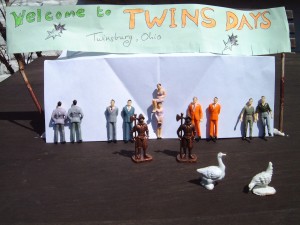
Young twins often form a closed community of two, with their own private language. But when you get 2,000 sets together, they form a kind of society that is difficult for “ordinary” people – singletons, as twins call us – to penetrate. I interview pair after pair and they all seem to say the same things: they come here every year because they love meeting other twins; they’re the only identicals back in Hicksville, and coming here makes them feel less freakish. “It’s fantastic, the camaraderie among all these people,” says David Hill of New York, who says he and his mirror-image brother, Sidney, were displayed in “chicken incubators” at a freak show on Coney Island after they were born in 1930. “And the barker in front of the show was Archibald Leach, who became Cary Grant,” adds Sidney.
Kristin and Kellie Savage, 23, graduated from the University of Denver, Colorado, and are both training to be science teachers. “It was a little weird being here at first,” says Kristin, “because we didn’t get to see many other twins before that. We’ve known maybe three sets, but they’re all girls – so we like to see some guys.”
Clumps of twins keep making human patterns. Every few seconds, two or three sets get together in symmetrical formations
As festivals go, the Twins Days seem a bit low-rent: there are shacks selling knick-knacks, talent shows in an entertainment tent, and an all-day chicken barbecue in the woods. But it is obvious that all these trimmings are as superfluous as a bookshelf in a brothel: the whole point of being here is to bond with other twins. And the bonding is sensational. Pairs of complete strangers seem continually, magnetically drawn to one another, to shake hands, slap backs – and, sometimes, take the relationship further. At times, there is so much touchy-feely communion that it makes a Club 18-30 event look like a Saga holiday.
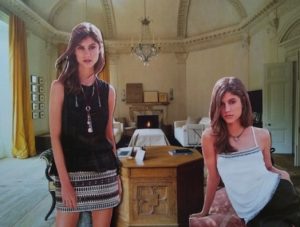
Another extraordinary thing is happening: clumps of twins keep making human patterns. Every few seconds, two or three or more sets get together in symmetrical formations and smile for somebody’s camera. They seem powerless to resist the compulsion, and watching it is like seeing the colours coalesce in a giant kaleidoscope.
But there are some Cinderellas at this party. Twins of all kinds are welcome, and that means fraternal as well as identical twins. While identical (or monozygotic) twins are the result of the fertilised egg splitting in the womb to create two individuals with the same genes, fraternal (or dizygotic) twins come from two separate eggs sharing the same womb, and are usually no more alike-looking than your average similar-aged siblings. Inevitably, then, as the identicals do all their kaleidoscopic strutting, the fraternals blend right into the background.
Most of the identical twins are sticking together, even walking in step. But it’s a myth that monozygotic twins always think and act identically. An extreme illustration is provided by a pair of 16-year-old male identicals here. Casey and Corey Washer are two cheeky-looking redheads from a Christian family in Columbus, Ohio, but Casey wears a yarmulke and Corey an oriental necklace. After dividing in the womb, they have taken separate spiritual paths. “I’m converting to Judaism,” says Casey. “I’m a Tibetan Buddhist,” says Corey. Sometimes, they say, they “disagree on stuff, like homosexuality and abortion”.
“It’s crazy on the weekends,” says their mother, Kelli, 38, “because on Friday night and Saturday, Casey’s at synagogue, then Corey is at temple on Sunday.” Can she account for their divergent viewpoints? “I think some of it is to do with birth order,” she says, “and I think some of it has to do with who their friends are; they have separate friends.”
With the nature-nurture debate still raging, twins are the researcher’s guinea pigs of choice
Some of the pairs walking around are just two siblings from a whole litter: triplets and other “multiples” are welcome here too. When I spot three men in matching bright green shirts, I head off in pursuit. I end up losing them somewhere between a garden stall and the chicken barbecue, but I make a mental note to look for them later.
***************************************************
According to the 1997 book Twins: Genes, Environment and the Mystery of Identity, by Lawrence Wright, one out of every 80 to 90 live births produces twins, and every person in about 150 is an identical twin. “Identical twinning,” says Wright, “is thought to occur on or before the 14th day after conception.” Scientists still can’t tell us why eggs divide during gestation, but science is mighty grateful that they do: twins make a fantastic laboratory resource, allowing boffins to determine to what extent a vast range of human traits are genetic or caused by our upbringing and environment. With the nature-nurture debate still raging, twins are the researcher’s guinea pigs of choice.
So an event like the Twins Days is a veritable honey pot for the scientific community. And for this August weekend, a little part of Twinsburg becomes a living laboratory. It sits between the baby-changing area and the indoor craft market: a yellow-and-white-striped tent full of clipboards, sterilised equipment and bustling lab coats.
The history of twin research has its horrors, of course. In the 1940s the Nazi doctor Josef Mengele experimented on thousands of twins in Auschwitz, during which the subjects were starved, poisoned, castrated, sterilised, mutilated and murdered in a chilling mockery of scientific method. But this is the 21st century, there are no mad scientists here with a twisted fascist agenda, and the word is out that there are rewards to be had – even hard cash – if twins consent to a few simple tests.
In a corner at the back of the tent is Dennis Drayna, a 51-year-old researcher from the National Institutes of Health, part of the US health service. He is recruiting twins to improve our understanding of central auditory processing – “or basically, what happens to sound after it reaches the ear. It’s what we use, for instance, to tell which direction sound is coming from. There’s a great deal of normal variation in this, and we don’t know how much of that is due to genetics and how much is due to environment. And a twin study is a particularly powerful way of asking that question”. To this end, Drayna packs off willing lookalikes to a trailer outside, where they put on headphones and spend about 15 minutes undergoing a hearing test. In return, they receive a free DNA test and tote bag. “We view it as a small window on the brain,” says Drayna. “If we can find genetic differences in this function, we can find the genes which encode those differences.” One benefit of the research, he adds, will be a better understanding of speech and language disorders.
Opposite Drayna is another research station, where twins are swigging mystery liquids out of cups. What is being tested here is their ability to discriminate different tastes and smells, and their olfactory sensitivities. “We’re looking at nature versus nurture, comparing identical with non-identical twins,” explains Paul Breslin of the Monell Chemical Senses Center, a nonprofit basic-research institute from Philadelphia.
This is where the Cinderellas come into their own: fraternal pairs of twins make invaluable scientific foils for identicals, says Breslin. This is because, while most fraternals are born into the same family structure at the same time, giving them a similar nurture history, they do not have the 100% gene-sharing of identicals. “The idea is, you expect identical twins to be much more concordant than non-identical twins,” he says. “If so, then that is a good demonstration that you’ve got a heritable trait.” Taste-test volunteers come away with a Monell towel, a little Etch A Sketch or a miniature tool kit.
A university is signing up female identical twins for a 30-day bed-rest study, testing the theory that astronauts can avoid the weakening of their muscles and bones
Serious money can be made by lying in bed for a month. Brandon Macias from the University of California, San Diego, is here signing up female identicals for “a 30-day bed-rest study, during which time they will remain in 6-degree head-down tilt to simulate space conditions”. UCSD is testing the theory that, by exercising in a kind of artificial gravity, astronauts can avoid the weakening of the muscles, bones and cardiovascular system that normally accompanies space flight. In this experiment, one supine twin gets the exercise, while the other, acting as the control, doesn’t. They get $100 a day for their trouble.
The most commercial operation here is Burke Pharmaceutical Research, which is conducting two studies, both of which test the efficacy of other companies’ products. Like the space-flight wheeze, they both involve using one twin as a control. “In one project, we’re looking at identical twin males with pattern hair loss,” says Dowling Stough, Burke’s medical director. “We’re giving one a drug that will maintain his hair and grow some back, and we’re giving the other one a placebo, a sugar pill.” He is also keeping an eye out for women with sun-damaged and wrinkled faces, to test two products by Allergan — Avage anti-wrinkle, anti-mottling cream, and Botox injections. “Allergan want to put one twin on Avage and the other on the vehicle cream. Then the one that gets the real McCoy, they want to treat her with Botox, and compare what Avage and Botox together do, versus nothing at all.” Balding or wrinkled twins walk away with $1,500, though they have to use some of that as travel money for follow-up tests.
Aren’t companies like Burke exploiting twins for their own ends? “No,” says Stough. “We use drugs that are already on the market, and most of the twins here would also seek treatment for those same conditions.” He indicates a couple of his female recruits. “These twins don’t really enjoy the wrinkles on their foreheads. I really don’t see the exploitation angle. They do get paid.”
One research station seems to differ from the rest in spirit – perhaps because the two women manning it are themselves twins. “Everyone is interested in twins as DNA,” says Dona Davis, a 55-year-old anthropologist from the University of South Dakota. Before embarking on a research project on twins with her monozygotic sister, Dorothy — also an anthropologist — Dona delved into the existing scientific literature and was alarmed at what she found. “Most of the literature is sub-cellular. And, frankly, I was a little miffed. I thought, ‘Where’s the voice for twins in here?’” The Davises are redressing the balance by interviewing adult identicals and tape-recording their stories for posterity. “This gives twins a voice, and says to people who do twin research, ‘Hey, wait a minute! We’re not just walking organ banks.’” Dona, whose work has previously involved collecting narratives from ordinary people in out-of-the-way places like Newfoundland, says the Twinsburg festival is a priceless opportunity. “It’s a year’s worth of data in two days.”
Like the camera-happy twins all around us, some of the twins’ stories are forming patterns, says Dona. “We’re hearing a lot of interesting mirror stories: a twin is somewhere on their own and they pass by a mirror, and suddenly think their twin is there with them. One set of twins told us that their mother had to sit them both in front of the mirror, because when one twin looked in the mirror, they thought it was the other twin.”
Have they heard about any instances of twin telepathy? “Some have said that whenever people meet them as twins, they ask, ‘Do you have ESP?’ They see it as the kind of question non-twins ask twins, and it’s kind of stupid. We’ve had two sets of twins thank us for not asking stupid questions about ESP.”
The Davises are disappointed by the gender mix of their volunteers. “We’re not getting many males,” says Dona. “We’re a social-science study: we can’t afford to pay people. And so men are, ‘If you can’t pay me, I’m not interested.’ Woman are just glad to talk about their experiences.” The anthropologists’ data may also be distorted by the fact that the people who come here are celebrating their status as twins – which is something not all twins want to do. “Right,” says Dona. “People coming here have invested in their twinship. We’re aware that that’s going to give us a little bit of a skew.”
Many of the scientists agree the that the willingness of the subjects here is unusual. “It’s really the best research subject population I have ever worked with,” says the auditory researcher Dennis Drayna. “People are here to enjoy themselves; as a result, we get people in a good mood. Also, twins know they’re special, and in many cases they like additional information on how they’re special.”
Coincidentally, Drayna is the father of 15-year-old male fraternal twins. “Last year we couldn’t get them to come here; they said, ‘I don’t want to do a twin thing; that’s stupid.’ Then we went on the internet and showed them photographs of 15-year-old female twins who attend. They said, ‘We’re going!’”
It has to be said that there are a lot of stunningly beautiful female twins here. I ask 29-year-old Tara and Tammy from Akron, Ohio, if they have been “hit on” by any male pairs. “Of course!” says Tammy. “Usually the young twin picks the young twin, and the older twin picks the older twin. “We hang out, have a good time,” says Tara, “and then we don’t see them till the following year.”
Suddenly I glimpse three bright green shirts in the distance. Breathless, I finally catch up with the three men in the craft tent. They introduce themselves as the Scott brothers from Texas. Are they triplets? No, they drawl: they constitute a pair of twins and their ordinary, singleton sibling — just like the Beverley Sisters. Damn.
The Sunday sun is setting on Twinsburg. After today, most of the people I meet aren’t going to be accompanied by a doppelgänger. But I have heard of a place that is even more astonishing, a destination that is hard to resist now that I have the bug. Instead of heading back to Cleveland airport, my taxi swings out west as I study my road map in the Ohio twilight. Tripletsburg shouldn’t be far from here. ♦
© 2014 Tony Barrell
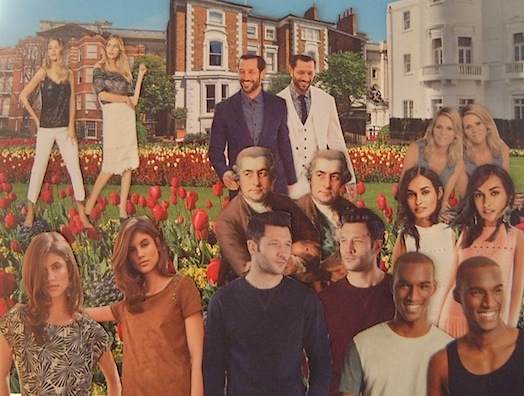
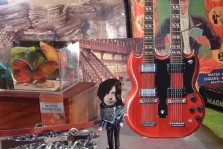
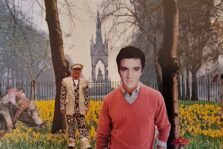
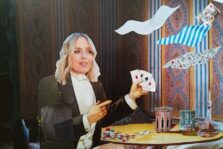
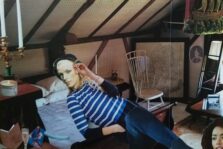




Pingback: Thousands of twins gather in Ohio every August. Here’s the fascinating history behind the tradition. – Dikla Akrat
Pingback: The History of the Twins Days Festival in Twinsburg, Ohio - Web Today
Pingback: Thousands of twins gather in Ohio every August. Here’s the fascinating history behind the tradition. - IverifyU